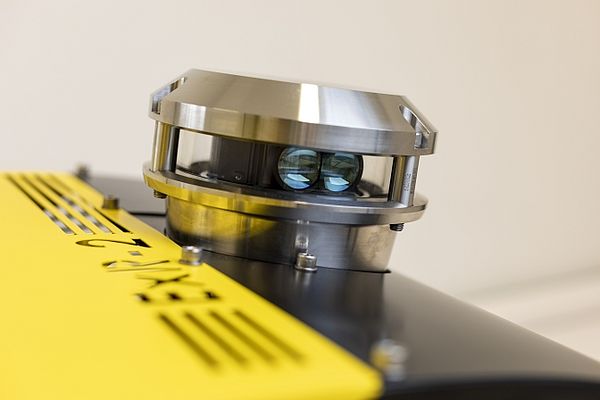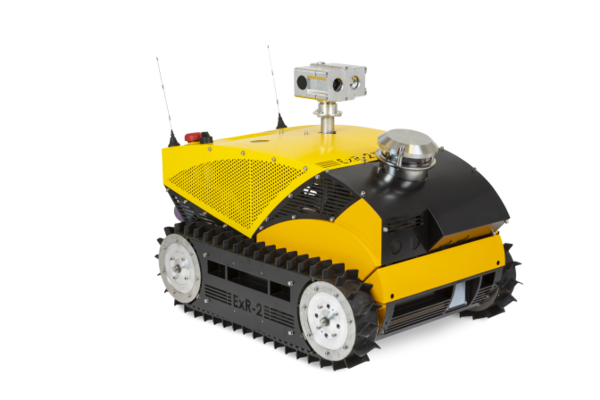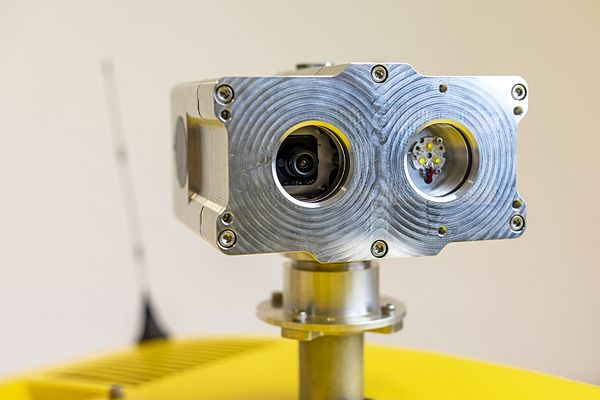The predecessor model ExR-1 was already successfully used more than 30 mobile inspection robots at 9 customers. With the ExR-2, Energy Robotics and ExRobotics are now taking a further step in their partnership: the new generation of IECEx/ATEX-certified inspection robots is equipped with LiDAR sensors (short for light detection and ranging or light imaging, detection and ranging) in addition to a GPS for the first time. This is a form of three-dimensional laser scanning which, in addition to creating high-resolution maps, is also used in the control and navigation of autonomous vehicles. With the help of the sensors, the ExR-2 recognises its location in the terrain and also avoids sudden obstacles.
In addition, the ExR-2 is able to independently target inspection points such as thermometers, pressure gauges or valves and check their indications or condition using machine vision. For this purpose, the robot was equipped by ExRobotics with a rotating and elevating camera, which has, among other things, a thermal imaging camera. Via other installed sensors, the ExR-2 can also monitor noises, detect leaks or map the concentration of gases in the air. The recorded values are read out by the integrated artificial intelligence of the Energy Robotics control software and sent securely via mobile network to the web-based interface of the employee in the control centre. On this basis, they can make informed decisions without exposing themselves to health risks.
"Many facilities in the oil and gas industry are unmanned and usually function smoothly that way. Nevertheless, they require regular checks, which until now have mostly been carried out by humans. However, this entails certain risks, both in terms of health and quality. Just like its predecessor, the ExR-2 is built to take on repetitive inspection tasks in such harsh environments," explains Iwan de Waard, Co-Founder and Director from ExRobotics. "In combination with the control software from our partner Energy Robotics, companies are able to monitor their plants remotely with the ExR-2 and carry out inspection rounds completely autonomously. In this way, they minimise the risks for their employees, detect gas leaks or accidents at an early stage and can thus usually avoid them."
Colleague robot on the move autonomously
The EXR-2 and its sensors are taught using the teach-and-repeat principle. With the help of Energy Robotics' control software, users complete this process from their own location via the web-based user interface. A Digital Twin, based on the environmental data captured by the robot, allows the user to track the ExR-2's current position in the plant on the screen. This allows inspection routes to be planned precisely and inspection points to be targeted accurately. No installation is required to commission the intuitive software. Users simply connect to the robot and run the inspection round once. To save inspection points, the sensors are aligned with the corresponding points. Users then select the type of inspection (visual, thermal, auditory, etc.) and the playback medium (audio, video, etc.).
Individual measuring points can be specified by naming them, and different inspection rounds can also be defined. The user interface also provides quick access to live video images and sensor data during later autonomous operation. These are sent from the ExR-2 to the user dashboard via the mobile network, protected by special security systems, whose access is additionally encrypted. The management of multiple inspection robots is also possible via the interface.
Safe inspection in high-risk areas
ExRobotics is the leading manufacturer of commercially deployed IECEx/ATEX zone 1 certified inspection robots and has designed its latest model so that its electronics are completely built inside. This ensures that the ExR-2's electronics will not ignite gases in sensitive and explosive industrial environments, the chain drive will not spark and sensors will not generate potentially dangerous heat. This means the robot is certified for use in IECEx and ATEX Zone 1 areas. A Zone 1 area is classified as a place in which an explosive atmosphere consisting of a mixture with air or flammable substances in the form of gas, vapour or mist is likely to occur in normal operation occasionally. IECEx is an international standard that regulates trade in equipment and services for use in potentially explosive atmospheres in compliance with the required safety levels, ATEX is the European counterpart to this standard.
"Inspection robots like the ExR-2 from ExRobotics relieve humans from working in dangerous environments. They take on tasks that humans should no longer be exposed to by now - not only because they involve a certain risk for them, but also because they for example have to carry heavy equipment over a longer distance to do so," knows Marc Dassler, Chief Executive Officer, Energy Robotics. "Our concern is to make the necessary work in such occupations more pleasant and safer. We enable robots to do this - with the help of our control software, they become intelligent enough to do so."
About Energy Robotics:
Founded in 2019 as a spin-off from the Technical University of Darmstadt, Energy Robotics is a pioneer in mobile robots for autonomous inspection of industrial facilities. The start-up offers the first commercially available software platform that brings together a hardware-independent robot operating system, cloud-based fleet management and AI-driven data analysis for industrial applications. Energy Robotics software-equipped mobile robots are used for remote inspection and monitoring in demanding environments such as the oil, gas, petrochemical, security and energy industries. More than 30 robots with a total of more than 25,000 operating hours are already in operation on four continents. Energy Robotics was funded at TU Darmstadt by the EXIST research transfer programme of the Federal Ministry for Economic Affairs and Energy (BMWi) and the European Social Fund. (ESF).



















